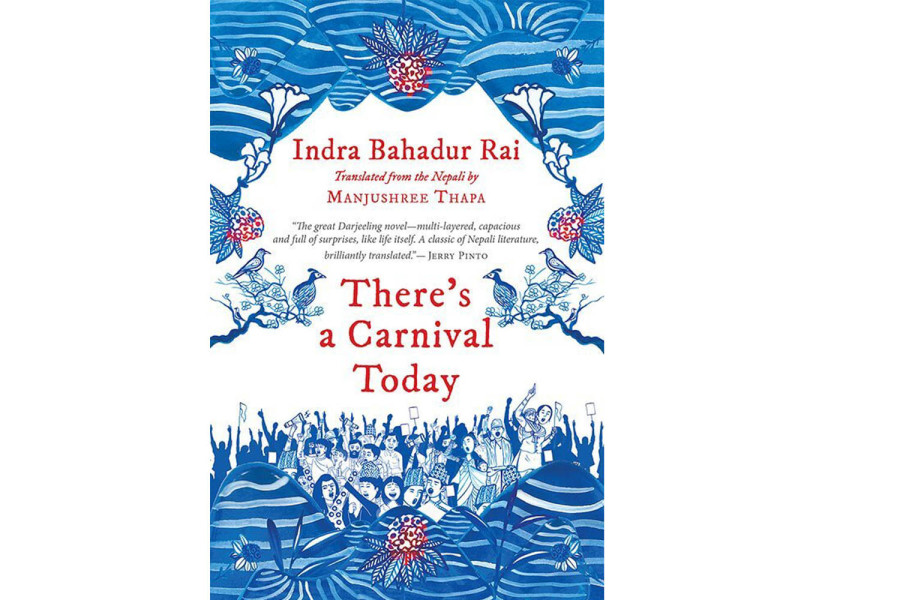
Readers seek an escape within the pages of a book, immersing themselves in its narrative. The writer’s skill lies in guiding this journey, shaping the setting in vivid detail, allowing readers to visualise and imagine the story’s world.
In ‘There’s a Carnival Today’ (‘Aja Ramita Cha’ in Nepali) by Indra Bahadur Rai, translated to English by Manjushree Thapa, the reader will find themselves in the 1950s Darjeeling, shortly after independence. The valley is home to people of different origins. Sita Shrestha, who journeyed from Dhankuta for her studies, falls in love with Janak Man Yonzan, who has just returned from studying in Calcutta. These two characters anchor the narrative, and their relationship acts as a window through which readers get to understand the setting and the nature of other characters. Alongside them, Pasang-la, the owner of a Tibetan restaurant, Janak’s creditor Jayabilas, and his Bengali friend Ajoy Das, contribute to the story’s rich cultural diversity.
The novel primarily focuses on a demonstration organised by locals in response to the mistreatment of tea plantation workers. This leads to a violent conflict between the workers and the plantation management, as they demand better pay and working conditions. Consequently, the story delves into the complexities of this dispute, offering insights into the post-independence situation in Darjeeling.
Additionally, through his diverse characters and their unique beliefs, Rai adeptly portrays the shifting political currents in post-independence Darjeeling. Janak’s youthful idealism, influenced by figures like Mahatma Gandhi, contrasts sharply with the more aggressive approach (described as ‘bullying tactics’ in the book) adopted by Bhudev. This clash of ideologies in the narrative sheds light on the intricate political atmosphere of the time and showcases Janak’s personal growth as a character.
The author pays meticulous attention to detail in the story. We are immersed in the characters’ lives, noticing even the smallest aspects like the environment, climate, and urban layout of the valley. Landmarks and cultural elements are used effectively, adding authenticity to the narrative. The enduring influence of Nepali language and culture in modern Darjeeling is depicted, reflecting the region’s deep connection with Nepal.
Rai’s storytelling style is skillfully captured in Thapa’s translation, retaining the essence of the original text for English-speaking readers. However, the unique storytelling approach, deliberately ‘disarranged’, might cause some confusion. Rai, in his note, explains this choice:
“I saw that life was moving forward, but not in an organised manner, with everything falling into place. I’ve disarranged this novel in a similar way. I didn’t see life as a singularity or as the chemical purity and unhindered progress of a single subjectivity.”
At the very beginning, Rai introduces Janak’s truck in a unique way, calling it ‘the labourer of society’ and an essential part of its driver’s life. Rai further describes it as a ‘factory for the owner’, resting by the roadside, yet crucial for society’s functioning. This perspective fascinated me. It made me see the truck as more than a machine. This unusual beginning captivated my interest, especially in how a simple truck could symbolise so much.
As the story unfolds, it delves into post-independence changes, like the advent of telephones and cinema, adding a historical layer. Everyday life, from evening trips to the bazaar to the presence of domestic help, paints a vivid picture of 1950s Darjeeling. The central theme of tension between labourers and plantation owners becomes a potent metaphor for the broader struggle for social justice. The protest, attended by diverse individuals, showcases cooperation and resilience in the face of injustice, making it a moving scene in the narrative.
‘There’s a Carnival Today’ combines a compelling narrative with deep explorations of social, political, and cultural themes. Rai’s storytelling, expertly translated by Thapa, makes it essential reading for anyone keen to understand the intricate dynamics of post-independence Darjeeling. This book not only entertains but also educates, offering incredible insights into how giving readers a profound understanding of the ability of literature can shed light on the human experience in a particular time and place.












